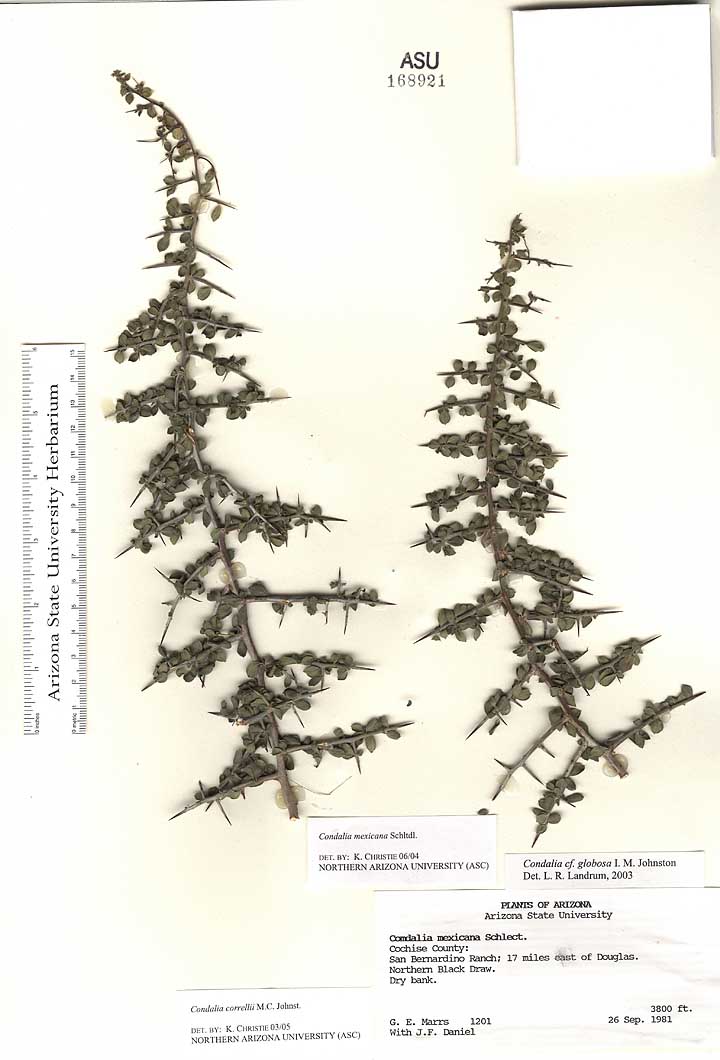Condalia
|
Family: Rhamnaceae |
PLANT: Thorny shrubs or small trees. STEMS: several to many, ascending; bark slightly furrowed to striated; branches alternate, the primary lateral branches thorn-tipped; twigs hispidulous; bud scales absent. LEAVES: deciduous, alternate or fascicled in clusters of 2-8 on lateral short shoots, sessile to subsessile; blades spatulate to obovate, pinnately veined, with 2-3 pairs of lateral veins, entire, hispidulous. INFLORESCENCE: axillary, cymose of 2-8 flowers, borne on lateral short shoots. FLOWERS: perfect, sessile to pedicellate, inconspicuous; hypanthium hemispheric, 1-1.5 mm wide, hispidulous to glabrous; sepals 5, greenish outside, yellowish within, deltate, 1 mm long; apetalous, stamens 5; ovary superior; style entire. FRUIT: a fleshy drupe, green, maturing to purple-black, globose or slightly elongate, glabrous to slightly pubescent; stones 1, smooth, distinctly beaked by a persistent style base, black to tan; seeds 1(-2). NOTES: 18 species in the Americas. (named for the Spanish physician Antonio Condal, 1745-1804). There has been debate about which Condalia species occur in AZ. Both regional floras and various herbarium collections have cited C. ericoides, C. correllii, C. mexicana, C. globosa var. pubescens, C. spathulata, and C. warnockii var. kearneyana as occurring in AZ. Condalia can be broadly segregated into three groups based on leaf shape: a linearleaved group, a broad-leaved group, and a spatulate-leaved group. Condalia ericoides (Microrhamnus ericoides) is quite unusual and can be identified by its light green, linear, revolute leaves; its distinctly football-shaped fruit; and its petal-bearing flowers. Condalia ericoides is primarily a Chihuahuan species that occurs in e NM, TX, and n Mex. The accounts of C. ericoides in AZ have arisen from misidentification and this species has not been vouchered within our range. The broad-leaved Condalia correlli and C. mexicana are also cited as occurring in AZ. M. C. Johnston (1962) separates these species by nuances of leaf color and venation, a slight difference in fruit length, as well as by overlapping characters of leaf size. These distinct taxa are closely related; however only C. correlli occurs in AZ. Some floras have mistakenly cited C. mexicana as occurring in AZ or at least mistakenly used the name C. mexicana for AZ material, however this taxon does not occur in the state. Condalia correllii occurs in AZ in s Cochise and Santa Cruz cos., and in Pima Co. in the Baboquivari Mountains and Chimena Canyon of the Rincon Mountains. Previous floristic treatments of the spatulate-leaved group of Condalia species have been problematic. M. C. Johnston separated C. globosa, C. warnockii, and C. spathulata based on characters of pedicel length, stone length to width ratio, internode length, leaf pubescence, and abaxial leaf venation. AZ specimens have been variously identified as all three of these species. Condalia spathulata has completel REFERENCES: Kyle Christie, Michael Currie, Laura Smith Davis, Mar-Elise Hill, Suzanne Neal, and Tina Ayers, 2006 Vascular Plants of Arizona: Rhamnaceae. CANOTIA 2(1): 23-46. |

